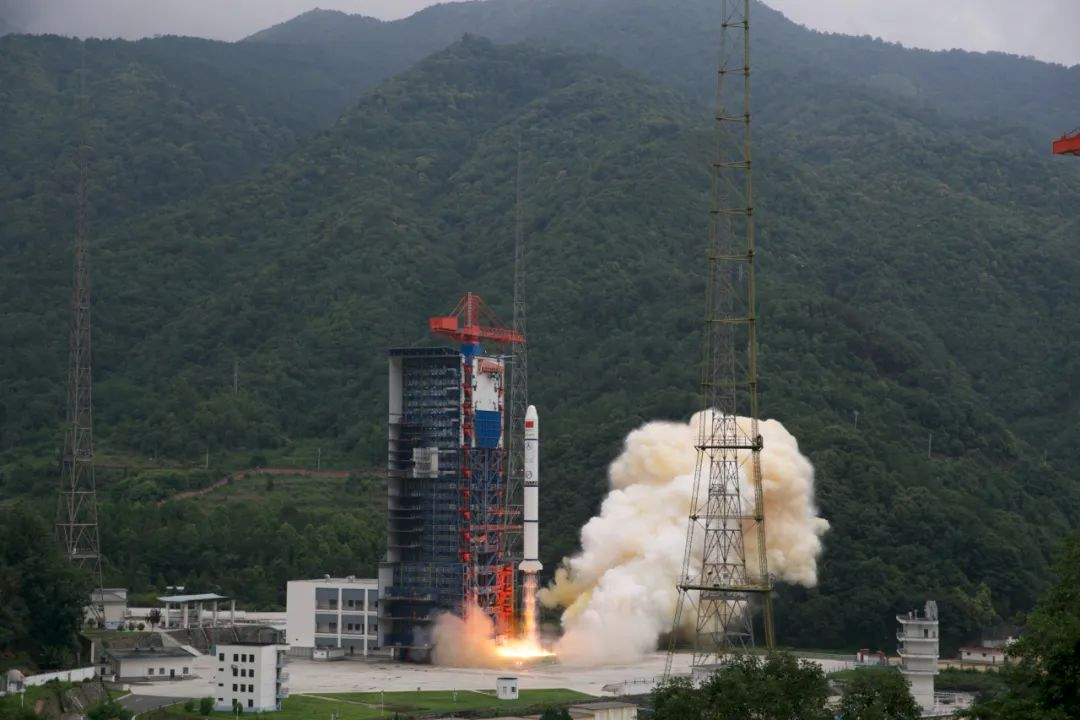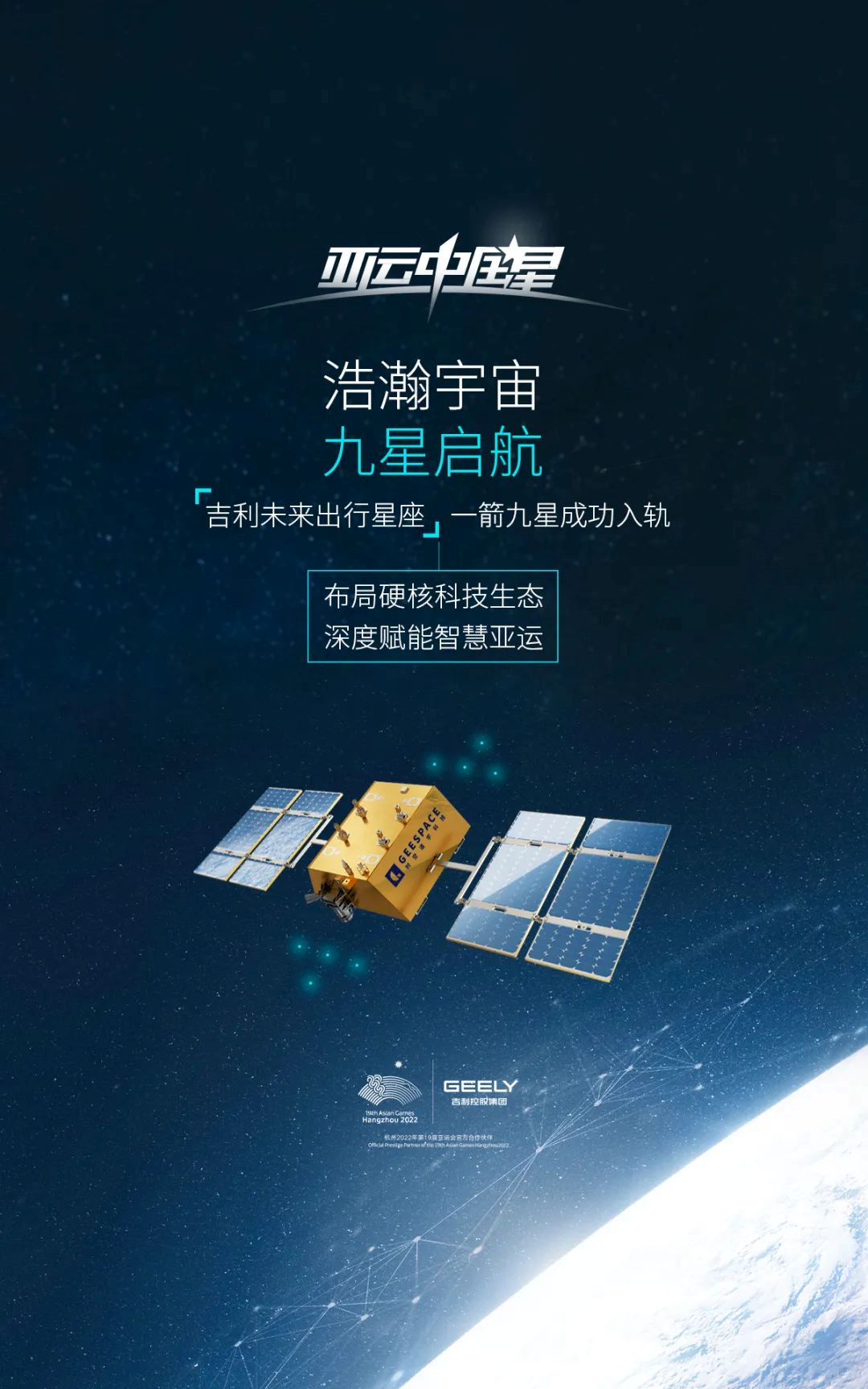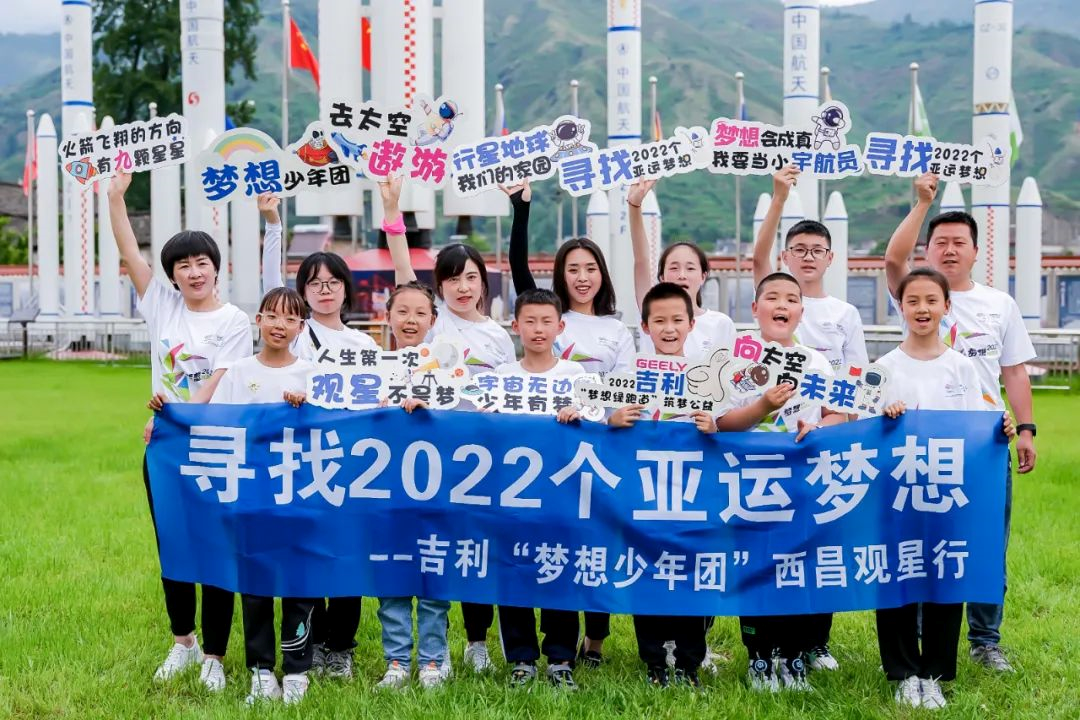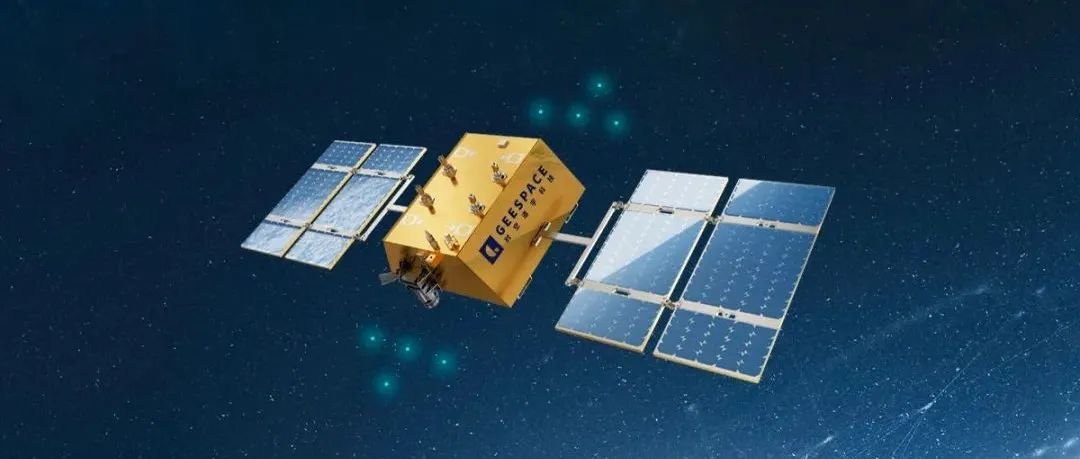Future Travel Constellation of Geely Successfully Launched!
Authored by: Lin Zelin
Edited by: Wang Pan
On June 2nd, 2022 at 12:00 pm, Geely’s Future Travel Constellation successfully launched the first track of its nine star system in the Xichang Satellite Launch Center using a one rocket nine satellite approach. The satellite successfully entered its designated orbit, making the launch mission a complete success.

Through the construction of the Future Travel Constellation, Geely Holding Group will construct an integrated high-precision space-time information system, creating an all-encompassing “Future Travel” ecology. The low-orbit satellite constellation, independently developed by Spatial Aerospace, combines with multidimensional carriers such as automobiles and intelligent terminals to empower intelligent travel, unmanned systems, intelligent cities, and other fields, creating a technology ecosystem for future travel.
The Geely Future Travel Constellation first track of the nine star system was completely independently developed by Geely Technology Group’s Zhejiang Spatial Aerospace Technology Co., Ltd. and was produced in its subsidiary Taizhou Satellite Super Factory. It has a designed life of five years.
Geely has come a long way, from two wheels to four wheels and now to space. It took Li Shufu 12 years to accomplish this idea.
As early as 2010, Li Shufu, chairman of Geely Holding Group, said, “While rooting ourselves on Earth, we should also cast our sights towards the vast universe with countless planets. With a more bold and scientific attitude, humanity should continue to explore and speed up the exploration of the space world and the future of the universe. While protecting and developing the Earth’s economy, we should open up an even broader world in the universe.”
In 2018, Geely strategically invested in Spatial Aerospace, officially opening the door for space exploration. Three years later, Geely Technology Group’s Commercial Space Headquarters was settled in Guangzhou Nansha. In September of the same year, the first product of the Starry Sky Alliance satellite factory was released, and Geely’s commercial satellites entered the mass production phase.
Also in 2010, Li Shufu had just signed a equity acquisition agreement at Volvo’s headquarters in Gothenburg, Sweden, becoming the largest overseas acquisition by a Chinese automaker at the time. Volvo, in fact, was the target Li Shufu had set his sights on back in 2002 when Geely first obtained the qualifications to produce small passenger cars.
From acquiring Volvo, becoming Daimler’s largest shareholder, entering the smartphone market, to manufacturing satellites, Li Shufu, known as the “car nut,” has always been willing to plant seeds that cannot be harvested in the short term.
Carmakers compete for “airspace rights”
Globally, Li Shufu is not the only one engaged in both satellite and automobile manufacturing. Tesla CEO Elon Musk has also long been involved in both industries, but in China, Geely is still the first. Earlier deployments often have first-mover advantages, especially in situations where orbit and frequency resource are limited.## Orbital Types
The orbit of a satellite can be classified as either geosynchronous (GEO), low earth (LEO), or medium earth (MEO) depending on its height above the earth. Resources for GEO orbits are limited, with almost half being controlled by the United States. Comparatively, LEO satellite orbit resources are more plentiful.
However, in recent years, the number of LEO satellites has greatly increased, primarily due to SpaceX’s Starlink project which began in 2018. Currently, roughly 1,800 Starlink satellites are in orbit, with Musk planning to launch between 12,000 to 42,000 LEO satellites from 2019 to 2024 to form the Starlink network, providing internet services.
Satellite frequencies also need to be applied for to the International Telecommunication Union (ITU) 3-5 years in advance, following the principle of “first come, first served.” Therefore, the strategic importance of occupying orbital and frequency resources is particularly significant, and satellite internet has recently been included in the scope of “new infrastructure” by the National Development and Reform Commission.
Integration of Space and Automotive Industries
If the current trend of smart cars being a combination of the smartphone, internet, and automotive industries is continued, the large-scale integration of the aerospace and automotive industries will also result in changes in commercial application scenarios.
Regarding the current trend of autonomous driving, both the pure visual route and the single-vehicle intelligent route combining laser radar with visual systems are still difficult to realize true autonomous driving.
Generally speaking, current driver assistance systems observe the road condition through the sensing system, compare it with the high-precision map, and continuously modify the position information of the vehicle to make the vehicle aware of its location. Many automakers have also used this technology to implement assisted driving functionality on highways and urban roads, but there are also certain risks and challenges involved.
An industry insider once revealed to Photon Planet that a certain automaker conducted a large number of tests and debugging on a fixed road section in a southern city and finally achieved unmanned driving on that road segment. However, due to the rapid growth of trees in the area, when the trees along the road changed, the vehicle was unable to recognize the road data and ended up “stuck in a rut.”
This is just one of many incidents involving autonomous driving, as vehicles have much stricter safety requirements than smartphones, and any error from a single component could potentially jeopardize human safety. The future of autonomous driving will undoubtedly result from a fusion of multiple complementary solutions.
Previously, spacetime aviation worked with Lynk & Co. to complete nationwide road testing of its “integrated high-precision timing and spatial information system.” In addition, Geely will provide onboard high-precision positioning services for the official vehicles of the Hangzhou Asian Games next year, able to complete tasks such as location information, driving record information, driver behavior analysis, and emergency communication.In the 9 satellites launched this time, one of them, named “Asia Game China Star”, was supported by the Olympic Council of Asia and the Hangzhou Asian Games Organizing Committee. With the aerospace-grade high-precision positioning, it provides characteristic services such as guaranteeing the torch relay of the Asian Games, guiding vehicle tracking, intelligent driving connection, and space eye watching the Asian Games.

In addition, in the era of 5G, data transmission and storage are inevitable topics. Musk hopes to provide low-cost Internet connection services globally through “Starlink”.
In the end, the host factories are competing to “escape” the ground, but ultimately it is to return to the ground.
On the ground, functional verification and debugging also require massive support. Currently, Geely has 3 million online vehicles and 12 billion kilometers of vehicle driving technology data. These data can also optimize high-precision positioning services in space, providing sufficient data support.
Traditional automakers find their rhythm
It should not be overlooked that new energy is not a sprint that only cares about acceleration but a marathon that tests endurance. Reasonable allocation of energy is far more effective than sprinting. Both internal strategic direction and external strategic conditions are equally important.
However, the emergence of new forces still subverts the thinking of many traditional car people. The car machine system has become a selling point, and basic assisted driving has become standard. The gap between users and host factories is getting closer and closer.
Most traditional automakers “hesitated for half a second” in the initial stage of new energy, and many car companies were led by new forces before they could react, establishing self-operated businesses, building communities, and working tirelessly. However, adapting to the speed of new forces is only the first step. To prepare enough for the second half of the game, it is necessary to clarify where their core advantages lie.
Currently, Changan has launched its first hydrogen fuel cell car, BYD is focusing on differentiated hybrid models, while Geely’s next era still adheres to diversification and long-termism as its core. Obviously, scale, funds, and higher tolerance are the core advantages of traditional automakers.
From the perspective of the nine satellites launched this time, the significance behind it is not only to provide services but also to lay out the entire industrial chain of commercial aerospace.
At present, the spatio-temporal system has formed a research and development system with the Shanghai Institute of Technical Physics as its core, and R&D centers in Xi’an, Nanjing, and Beijing as its support, covering the entire industrial chain from satellite research and development, manufacturing, measurement and control, and application. It also includes two major business operation headquarters in Guangzhou and Qingdao, as well as a satellite super factory manufacturing base in Taizhou.
Similarly, Geely is also beginning to make efforts in the chip field. Its sub-brand Techfront released the first domestically produced 7nm vehicle-grade cockpit chip “Dragon Eagle 1” last year. The performance of this chip will compete with the currently mainstream cockpit product, the Qualcomm SA8155P chip.According to Dr. Wang Kai from Xinquan Technology, in addition to the smart cockpit chip, they will also self-develop an autonomous driving chip for L2/L3 autonomous driving. Moreover, Xinquan Technology plans to include the central gateway processor and the car-rule-level MCU.
In addition, the GEEA2.0 electronic and electrical architecture, four architectures including BMA, CMA, SPA, SEA, and mobile phone business are all closely working together to build a stable ecosystem for Geely.
As observed in recent years, regardless of Internet technology companies or hardware companies, they are unhappy with the idea of just having a single product or software, instead they have started to seek layout in the entire industry chain to improve their competitiveness. The next stage of competition in the whole Industry chains competition is cross-industry competition, and the layout of Geely’s various businesses is also fully preparing itself for cross-industry competition.
Of course, the biggest difficulty of technology is how to combine with business and form a closed loop.
Geely Holding Group’s multi-brand strategy has played a great effectiveness, with many brands covering from low-end to high-end in the passenger car sector such as Geely Auto, Lynk & Co., Volvo, and Geometry, which have remote vehicles in the commercial vehicle sector, and Caocao Travel, Yao Travel for sharing travel. Also, they have Volocopter, which involves low-altitude travel. This laid a foundation for the development of a series of businesses such as advanced assisted driving, autonomous driving, Robotaxi, and Robotruck.
Through satellite remote sensing AI data services, Geometry users can view world HD satellite street view images in the car at any time. In addition, high-performance remote sensing AI data services can also continuously monitor marine ecological environments, providing services for Geely’s “Blue Star Guardian” public welfare project.
The “Dragon Eagle No.1” that will be put into mass production at the end of this year will be gradually installed on popular Geely models. Similarly, in addition to the Geely Holding Group, Dr. Wang Kai also revealed that “Dragon Eagle No.1” will be extended to other industries outside the automotive industry.
In 2019, Yika Tong launched the GKUI smart car machine product, which was installed on the Geely Bo Yue Pro. Currently, Yika Tong Technology has 12 OEM customers and 8 global Tier 1 supplier customers, with products installed on 3.2 million vehicles.
Whether it is satellites, software, chips, platforms, or mobile phone businesses, suitable products can be found within the internal system of Geely and radiated externally.
Geely has now become the leader in the industry by acquiring Volvo in 2010, and six years later, Geely Holding Group, Geely Automobile Group, and Volvo Automobiles jointly established Lynk & Co., and developed products based on the jointly developed CMA platform. As Geely’s own brand, Lynk & Co.’s sales volume in 2021 has reached about 220,000, and it has led its competitors by one position.From CMA architecture to SPA architecture, Geely, inheriting Volvo’s experience and technology, further developed its technology through Lynk & Co, passing on the CMA modular architecture to Geely in 2019, creating multiple models such as the Star Yue, Star Yue L, and Star Rui.
In 2021, Geely’s China Star series, based on the CMA architecture, sold a total of 210,000 vehicles. The Geely brand also achieved five consecutive years as the top-selling Chinese brand for passenger cars.
Similarly, the SEA architecture, which began development in 2016, is beginning to gain traction in the new energy market. In May, the latest delivery data for the Zeekrxueyuan 001, based on the SEA architecture, exceeded 4,000 units, a 102.6% increase from the previous month, with total deliveries exceeding 20,000 units.
With the SEA architecture as a “calling card,” Geely has partnered with brands such as Baidu, Mercedes-Benz, and Volvo, driven both by financial interests and the desire to learn from their experience and technology.
Certainly, Geely’s layout is very broad, and some industries are still in the early stages of development, yet to show sufficient ecological synergy. However, Geely, supported by a long-term perspective, has already entered the “harvesting period” due to more than 20 years of investment, and future investment will continue to bring unexpected returns.

At the Xichang Satellite Launch Center, nine teenagers from Geely Dream Team looked up at a rocket carrying nine satellites slowly rising into the sky. No one knows if the next Li Shufu or Elon Musk will emerge among them, but planting the seeds and waiting for them to sprout is an eternal truth in society, business, and even life.
This article is a translation by ChatGPT of a Chinese report from 42HOW. If you have any questions about it, please email bd@42how.com.
